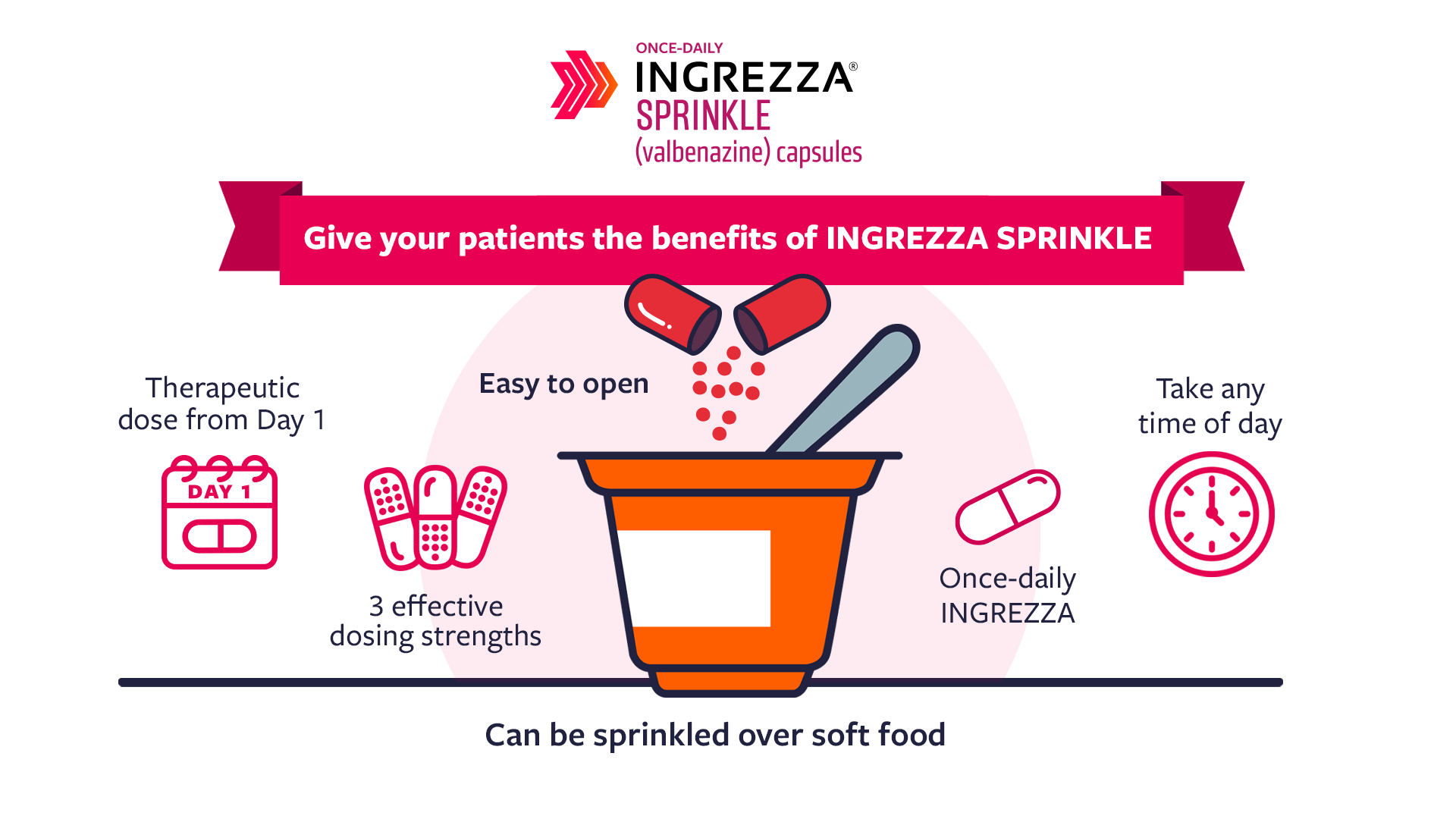Recommended dose is 80 mg.
Adjust based on response and tolerability.
Capsules not actual size
This website is intended for US healthcare professionals only.
See dosing for TARDIVE DYSKINESIA (TD)
See dosing for Huntington’s disease (hd) chorea
No other VMAT2 inhibitor can offer
the simplicity of INGREZZA1:
Why wait?
Therapeutic dose from Day 1
Why titrate?
No required titration
Why overcomplicate?
Start with INGREZZA



Actor portrayal
Request samples of INGREZZA® (valbenazine) capsules today to start patients on treatment
DOSING FOR Tardive dyskinesia (TD)
DOSING FOR
Tardive dyskinesia
DOSING FOR Huntington’s disease (HD) chorea
DOSING FOR
HD chorea


Recommended dose is 80 mg.
Adjust based on response and tolerability.
Capsules not actual size
85%
took second-generation antipsychotics
27%
took first-generation antipsychotics
In KINECT 3, the most common types of concomitant medications were2,3:
INGREZZA1
AUSTEDO® (deutetrabenazine) and AUSTEDO XR® (deutetrabenazine)4,a
STUDIED?
STUDIED?
Elderly Patients
(≥65 years)
STUDIED?

NO ADJUSTMENT REQUIRED
STUDIED?
Dose selection should be cautious


Renal impairment
STUDIED?

NO ADJUSTMENT REQUIRED
STUDIED?



Hepatic impairment
STUDIED?

40 mg once daily
MODERATE-SEVERE IMPAIRMENT
STUDIED?



Concomitant anticholinergics
(eg, benztropine)
STUDIED?

Patients on anticholinergics INCLUDED in pivotal trial
STUDIED?

Patients on anticholinergics EXCLUDED from pivotal trial
Dosing considerations do not imply differences in safety, efficacy, or clinical outcomes.
aAUSTEDO® and AUSTEDO XR® are trademarks of Teva Pharmaceutical Industries Ltd.
*See deutetrabenazine prescribing information section 8.5.
†See deutetrabenazine prescribing information section 12.3.
‡See deutetrabenazine prescribing information section 8.6.


Recommended dose is 80 mg.
Adjust based on response and tolerability.
*Increase the dose in 20 mg increments every two weeks to the recommended dose.
Capsules not actual size
The initial dosage for INGREZZA is 40 mg once daily. Increase the dose in 20 mg increments every two weeks to the recommended dosage of 80 mg once daily. A dosage of 40 mg or 60 mg once daily may be considered depending on response and tolerability.1
INGREZZA1
AUSTEDO® (deutetrabenazine) and AUSTEDO XR® (deutetrabenazine)4,a
STUDIED?
STUDIED?
Renal impairment
STUDIED?

NO ADJUSTMENT REQUIRED
STUDIED?



Hepatic impairment
STUDIED?

40 mg once daily
MODERATE-SEVERE IMPAIRMENT
STUDIED?



Elderly Patients
(≥65 years)
No dose adjustment required
Dose selection should be cautious§
Dosing considerations do not imply differences in safety, efficacy, or clinical outcomes.
aAUSTEDO® and AUSTEDO XR® are trademarks of Teva Pharmaceutical Industries Ltd.
†See deutetrabenazine prescribing information section 12.3.
‡See deutetrabenazine prescribing information section 8.6.
§See deutetrabenazine prescribing information section 8.5.
INGREZZA1
AUSTEDO® (deutetrabenazine) and AUSTEDO XR® (deutetrabenazine)4,b
STUDIED?
STUDIED?
Strong CYP2D6 inhibitors (eg, paroxetine, fluoxetine, quinidine)
STUDIED?

90% increase in exposure to active metabolite
Recommended dosage is 40 mg/day
STUDIED?

550% increase in exposure to active metabolite
Max dosage of 36 mg/day
INGREZZA1
AUSTEDO® (deutetrabenazine) and AUSTEDO XR® (deutetrabenazine)4,b
Poor CYP2D6 metabolizers
STUDIED?

90% increase in exposure to active metabolite
Recommended dosage is 40 mg/day
STUDIED?



Max dosage of 36 mg/day
INGREZZA1
AUSTEDO® (deutetrabenazine) and AUSTEDO XR® (deutetrabenazine)4,b
Strong CYP3A4 inhibitors
(eg, itraconazole, ketoconazole, clarithromycin)
STUDIED?

110% increase in exposure to active metabolite
Recommended dosage is 40 mg/day
STUDIED?



INGREZZA1
AUSTEDO® (deutetrabenazine) and AUSTEDO XR® (deutetrabenazine)4,b
Strong CYP3A4 inducers
(eg, rifampin, phenytoin, carbamazepine, St. John’s wort)
STUDIED?

NO ADDED SAFETYADDED SAFETY CONCERNS
80% decrease in exposure to active metabolite
Not recommended due to subtherapeutic exposure
STUDIED?



Dosing considerations do not imply differences in safety, efficacy, or clinical outcomes
bAUSTEDO® and AUSTEDO XR® are trademarks of Teva Pharmaceutical Industries Ltd.
$10 or less out-of-pocket is what most patients pay for INGREZZA8
SAVINGS & SUPPORT¶Based on in vitro VMAT2 binding affinity of dihydrotetrabenazine (HTBZ) metabolites and the primary active metabolite of INGREZZA, + α HTBZ. The clinical significance of in vitro data is unknown and is not meant to imply clinical outcomes.
REFERENCES:
INGREZZA® (valbenazine) capsules and INGREZZA® SPRINKLE (valbenazine) capsules are indicated in adults for the treatment of tardive dyskinesia and for the treatment of chorea associated with Huntington’s disease.
Depression and Suicidality in Patients with Huntington’s Disease: VMAT2 inhibitors, including INGREZZA and INGREZZA SPRINKLE, can increase the risk of depression and suicidal thoughts and behavior (suicidality) in patients with Huntington’s disease. Balance the risks of depression and suicidality with the clinical need for treatment of chorea. Closely monitor patients for the emergence or worsening of depression, suicidal ideation, or unusual changes in behavior. Inform patients, their caregivers, and families of the risk of depression and suicidal ideation and behavior and instruct them to report behaviors of concern promptly to the treating physician. Exercise caution when treating patients with a history of depression or prior suicide attempts or ideation, which are increased in frequency in patients with Huntington’s disease.
INGREZZA and INGREZZA SPRINKLE are contraindicated in patients with a history of hypersensitivity to valbenazine or any components of INGREZZA or INGREZZA SPRINKLE.
Hypersensitivity reactions, including cases of angioedema involving the larynx, glottis, lips, and eyelids, have been reported in patients after taking the first or subsequent doses of INGREZZA. Angioedema associated with laryngeal edema can be fatal. If any of these reactions occur, discontinue INGREZZA or INGREZZA SPRINKLE.
INGREZZA and INGREZZA SPRINKLE can cause somnolence and sedation. Patients should not perform activities requiring mental alertness such as operating a motor vehicle or operating hazardous machinery until they know how they will be affected by INGREZZA or INGREZZA SPRINKLE.
INGREZZA and INGREZZA SPRINKLE may prolong the QT interval, although the degree of QT prolongation is not clinically significant at concentrations expected with recommended dosing. INGREZZA and INGREZZA SPRINKLE should be avoided in patients with congenital long QT syndrome or with arrhythmias associated with a prolonged QT interval. For patients at increased risk of a prolonged QT interval, assess the QT interval before increasing the dosage.
A potentially fatal symptom complex referred to as Neuroleptic Malignant Syndrome (NMS) has been reported in association with drugs that reduce dopaminergic transmission, including INGREZZA. The management of NMS should include immediate discontinuation of INGREZZA or INGREZZA SPRINKLE, intensive symptomatic treatment and medical monitoring, and treatment of any concomitant serious medical problems. If treatment with INGREZZA or INGREZZA SPRINKLE is needed after recovery from NMS, patients should be monitored for signs of recurrence.
INGREZZA and INGREZZA SPRINKLE may cause parkinsonism. Parkinsonism has also been observed with other VMAT2 inhibitors. Reduce the dose or discontinue INGREZZA or INGREZZA SPRINKLE treatment in patients who develop clinically significant parkinson-like signs or symptoms.
The most common adverse reaction in patients with tardive dyskinesia (≥5% and twice the rate of placebo) is somnolence.
The most common adverse reactions in patients with chorea associated with Huntington’s disease (≥5% and twice the rate of placebo) are somnolence/lethargy/sedation, urticaria, rash, and insomnia.
You are encouraged to report negative side effects of prescription drugs to the FDA. Visit MedWatch at www.fda.gov/medwatch or call 1-800-FDA-1088.
Dosage Forms and Strengths: INGREZZA and INGREZZA SPRINKLE are available in 40 mg, 60 mg, and 80 mg capsules.
Please see full Prescribing Information, including Boxed Warning.
Depression and Suicidality in Patients with Huntington’s Disease: VMAT2 inhibitors, including INGREZZA, can increase the risk of depression and suicidal thoughts and
INGREZZA® (valbenazine) capsules and INGREZZA® SPRINKLE (valbenazine) capsules are indicated in adults for the treatment of tardive dyskinesia and for the treatment of chorea associated with Huntington’s disease.
Depression and Suicidality in Patients with Huntington’s Disease: VMAT2 inhibitors, including INGREZZA and INGREZZA SPRINKLE, can increase the risk of depression and suicidal thoughts and behavior (suicidality) in patients with Huntington’s disease. Balance the risks of depression and suicidality with the clinical need for treatment of chorea. Closely monitor patients for the emergence or worsening of depression, suicidal ideation, or unusual changes in behavior. Inform patients, their caregivers, and families of the risk of depression and suicidal ideation and behavior and instruct them to report behaviors of concern promptly to the treating physician. Exercise caution when treating patients with a history of depression or prior suicide attempts or ideation, which are increased in frequency in patients with Huntington’s disease.
INGREZZA® (valbenazine) capsules and INGREZZA® SPRINKLE (valbenazine) capsules are indicated in adults for the treatment of tardive dyskinesia and for the treatment of chorea associated with Huntington’s disease.
Depression and Suicidality in Patients with Huntington’s Disease: VMAT2 inhibitors, including INGREZZA and INGREZZA SPRINKLE, can increase the risk of depression and suicidal thoughts and behavior (suicidality) in patients with Huntington’s disease. Balance the risks of depression and suicidality with the clinical need for treatment of chorea. Closely monitor patients for the emergence or worsening of depression, suicidal ideation, or unusual changes in behavior. Inform patients, their caregivers, and families of the risk of depression and suicidal ideation and behavior and instruct them to report behaviors of concern promptly to the treating physician. Exercise caution when treating patients with a history of depression or prior suicide attempts or ideation, which are increased in frequency in patients with Huntington’s disease.
INGREZZA and INGREZZA SPRINKLE are contraindicated in patients with a history of hypersensitivity to valbenazine or any components of INGREZZA or INGREZZA SPRINKLE.
Hypersensitivity reactions, including cases of angioedema involving the larynx, glottis, lips, and eyelids, have been reported in patients after taking the first or subsequent doses of INGREZZA. Angioedema associated with laryngeal edema can be fatal. If any of these reactions occur, discontinue INGREZZA or INGREZZA SPRINKLE.
INGREZZA and INGREZZA SPRINKLE can cause somnolence and sedation. Patients should not perform activities requiring mental alertness such as operating a motor vehicle or operating hazardous machinery until they know how they will be affected by INGREZZA or INGREZZA SPRINKLE.
INGREZZA and INGREZZA SPRINKLE may prolong the QT interval, although the degree of QT prolongation is not clinically significant at concentrations expected with recommended dosing. INGREZZA and INGREZZA SPRINKLE should be avoided in patients with congenital long QT syndrome or with arrhythmias associated with a prolonged QT interval. For patients at increased risk of a prolonged QT interval, assess the QT interval before increasing the dosage.
A potentially fatal symptom complex referred to as Neuroleptic Malignant Syndrome (NMS) has been reported in association with drugs that reduce dopaminergic transmission, including INGREZZA. The management of NMS should include immediate discontinuation of INGREZZA or INGREZZA SPRINKLE, intensive symptomatic treatment and medical monitoring, and treatment of any concomitant serious medical problems. If treatment with INGREZZA or INGREZZA SPRINKLE is needed after recovery from NMS, patients should be monitored for signs of recurrence.
INGREZZA and INGREZZA SPRINKLE may cause parkinsonism. Parkinsonism has also been observed with other VMAT2 inhibitors. Reduce the dose or discontinue INGREZZA or INGREZZA SPRINKLE treatment in patients who develop clinically significant parkinson-like signs or symptoms.
The most common adverse reaction in patients with tardive dyskinesia (≥5% and twice the rate of placebo) is somnolence.
The most common adverse reactions in patients with chorea associated with Huntington’s disease (≥5% and twice the rate of placebo) are somnolence/lethargy/sedation, urticaria, rash, and insomnia.
You are encouraged to report negative side effects of prescription drugs to the FDA. Visit MedWatch at www.fda.gov/medwatch or call 1-800-FDA-1088.
Dosage Forms and Strengths: INGREZZA and INGREZZA SPRINKLE are available in 40 mg, 60 mg, and 80 mg capsules.
Please see full Prescribing Information, including Boxed Warning.